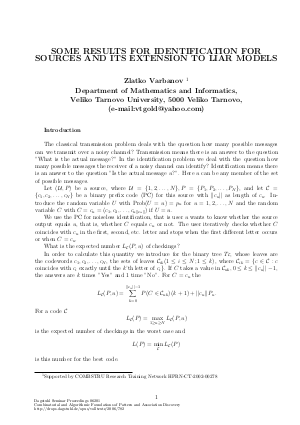Some Results for Identification for Sources and its Extension to Liar Models
Author Zlatko Varbanov
-
Part of:
Volume:
Dagstuhl Seminar Proceedings, Volume 6201
Part of: Series: Dagstuhl Seminar Proceedings (DagSemProc) - License:
 Creative Commons Attribution 4.0 International license
Creative Commons Attribution 4.0 International license
- Publication Date: 2006-11-07
File

PDF
DagSemProc.06201.8.pdf
- Filesize: 126 kB
- 4 pages
Document Identifiers
Subject Classification
Keywords
- Identification for sources
- lies
- prefix code
Metrics
- Access Statistics
-
Total Accesses (updated on a weekly basis)
0Document
0Metadata
Abstract
Let (${cal U}, P$) be a source, where ${cal U} =
{1,2,dots,N}, P = {P_1, P_2, dots, P_N}$, and let ${cal C}
= {c_1,c_2,dots,c_N}$ be a binary prefix code (PC) for this
source with $||c_u||$ as length of $c_u$. Introduce the random
variable $U$ with Prob($U=u$) = $p_u$ for $u = 1,2,dots,N$ and
the random variable $C$ with $C = c_u =
(c_1,c_2,dots,c_{u||c_u||})$ if $U=u$. We use the PC for
noiseless identification, that is user $u$ wants to know whether
the source output equals $u$, that is, whether $C$ equals $c_u$ or
not. The user iteratively checks whether $C$ coincides with $c_u$
in the first, second, etc. letter and stops when the first
different letter occurs or when $C = c_u$. What is the expected
number $L_{cal C}(P,u)$ of checkings?
In order to calculate this quantity we introduce for the binary
tree $T_{cal C}$, whose leaves are the codewords
$c_1,c_2,dots,c_N$, the sets of leaves ${cal C}_{ik} (1 leq i
leq N; 1 leq k)$, where ${cal C}_{ik} = {c in {cal C}: c$
coincides with $c_i$ exactly until the $k$'th letter of $c_i}$.
If $C$ takes a value in ${cal C}_{uk}, 0 leq k leq ||c_u||-1$,
the answers are $k$ times "Yes" and 1 time "No". For $C = c_u$ the
$$
L_{cal C}(P,u) = sum_{k=0}^{||c_u||-1}P(C in {cal
C}_{uk})(k+1) + ||c_u||P_u.
$$
For code ${cal C}$,~ $L_{cal C}(P) = max L_{cal C}(P,u)$, $1
geq u geq N$, is the expected number of checkings in the worst
case and $L(P) = min L_{cal C}(P)$ is this number for the best
code ${cal C}$.
Let $P = P^N = {frac{1}{N}, dots, frac{1}{N}}$. We construct
a prefix code ${cal C}$ in the following way. In each node
(starting at the root) we split the number of remaining codewords
in proportion as close as possible to $(frac{1}{2},frac{1}{2})$.
It is known that
$$
lim_{N
ightarrow infty} L_{cal C}(P^N) = 2
$$
(Ahlswede, Balkenhol, Kleinewachter, 2003)
We know that $L(P) leq 3$ for all $P$ (Ahlswede, Balkenhol, Kleinewachter, 2003). Also, the problem to estimate an universal
constant $A = sup L(P)$ for general $P = (P_1,dots, P_N)$ was stated (Ahlswede, 2004). We
compute this constant for uniform distribution and this code
${cal C}$.
$$
sup_N L_{cal C}(P^N) = 2+frac{log_2(N-1)-2}{N}
$$
Also, we consider the average number of checkings, if code ${cal
C}$ is used: $ L_{cal C}(P,P) = sum P_u L_{cal C}(P,u)$, for
${u in {cal U}}$. We calculate the exact values of $L_{cal
C}(P^N)$ and $L_{cal C}(P^N,P^N)$ for some $N$.
Other problem is the extension of identification for sources to
liar models. We obtain a upper bound for the expected number of
checkings $L_{cal C}(P^N;e)$, where $e$ is the maximum number of
lies.
$$
L_{cal C}(P^N;e) leq M_{cal C}(P^N;e) = (e+1)L_{cal C}(P^N) +
e; ~~ lim_{N
ightarrow infty} M_{cal C}(P^N;e) = 3e+2
$$
Cite As Get BibTex
Zlatko Varbanov. Some Results for Identification for Sources and its Extension to Liar Models. In Combinatorial and Algorithmic Foundations of Pattern and Association Discovery. Dagstuhl Seminar Proceedings, Volume 6201, pp. 1-4, Schloss Dagstuhl – Leibniz-Zentrum für Informatik (2006)
https://doi.org/10.4230/DagSemProc.06201.8
BibTex
@InProceedings{varbanov:DagSemProc.06201.8,
author = {Varbanov, Zlatko},
title = {{Some Results for Identification for Sources and its Extension to Liar Models}},
booktitle = {Combinatorial and Algorithmic Foundations of Pattern and Association Discovery},
pages = {1--4},
series = {Dagstuhl Seminar Proceedings (DagSemProc)},
ISSN = {1862-4405},
year = {2006},
volume = {6201},
editor = {Rudolf Ahlswede and Alberto Apostolico and Vladimir I. Levenshtein},
publisher = {Schloss Dagstuhl -- Leibniz-Zentrum f{\"u}r Informatik},
address = {Dagstuhl, Germany},
URL = {https://drops.dagstuhl.de/entities/document/10.4230/DagSemProc.06201.8},
URN = {urn:nbn:de:0030-drops-7820},
doi = {10.4230/DagSemProc.06201.8},
annote = {Keywords: Identification for sources, lies, prefix code}
}
